Sweetened with honey instead of granulated sugar, this Honey Sourdough Bread is soft and delicious. With a beautiful airy, fluffy crumb and a golden brown exterior, this has quickly become one of our family favorites. Enjoy it with a little butter and jam for breakfast or create a delicious sandwich for lunch.
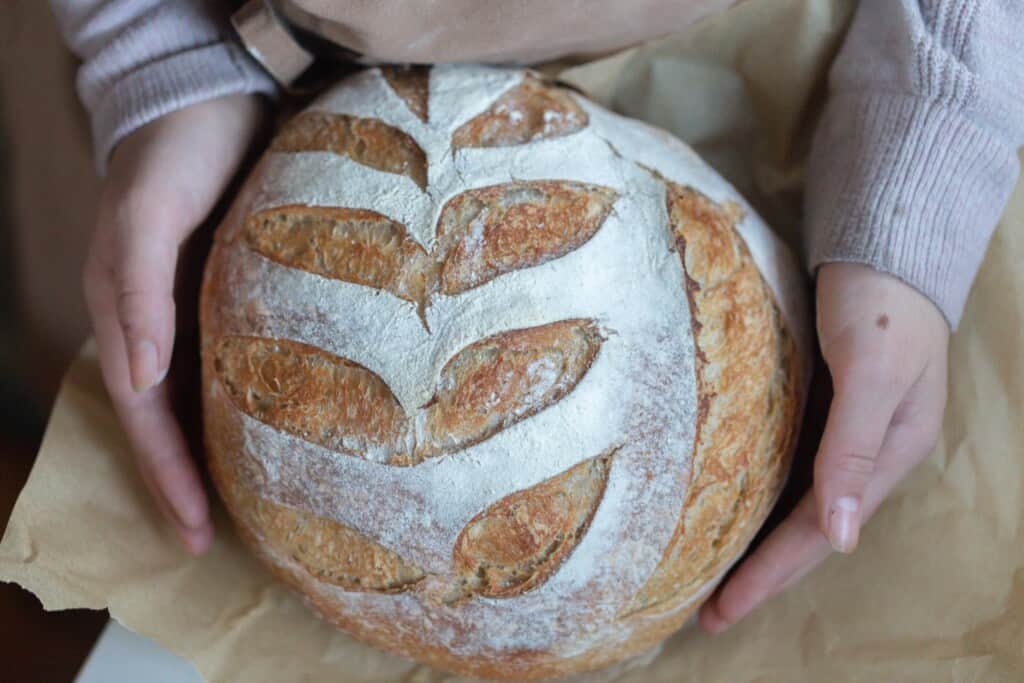
I get asked a lot about subbing honey for regular granulated sugar.
You’ll find I use honey in many of my recipes. I love to use it in my no-knead 100% whole wheat sourdough bread because it makes it much softer and less dense than it would be without it.
Subbing it in recipes that call for sugar is not usually as simple as a one-to-one sub, though. So, for those of you honey lovers out there, I decided to experiment making my no-knead loaf with this delicious natural sweetener!
I have to say, I loved the end result! Honey yields a softer loaf with that tangy flavor and crusty exterior we all know and love. My kids can’t get enough of it. I have a feeling I’ll be making this loaf on repeat now for quite some time.
We have been enjoying a slice for breakfast. With a little raw milk butter on top, its a perfect side for our farm fresh eggs.
If you love this recipe as much as I do, I’d suggest stocking up on honey!
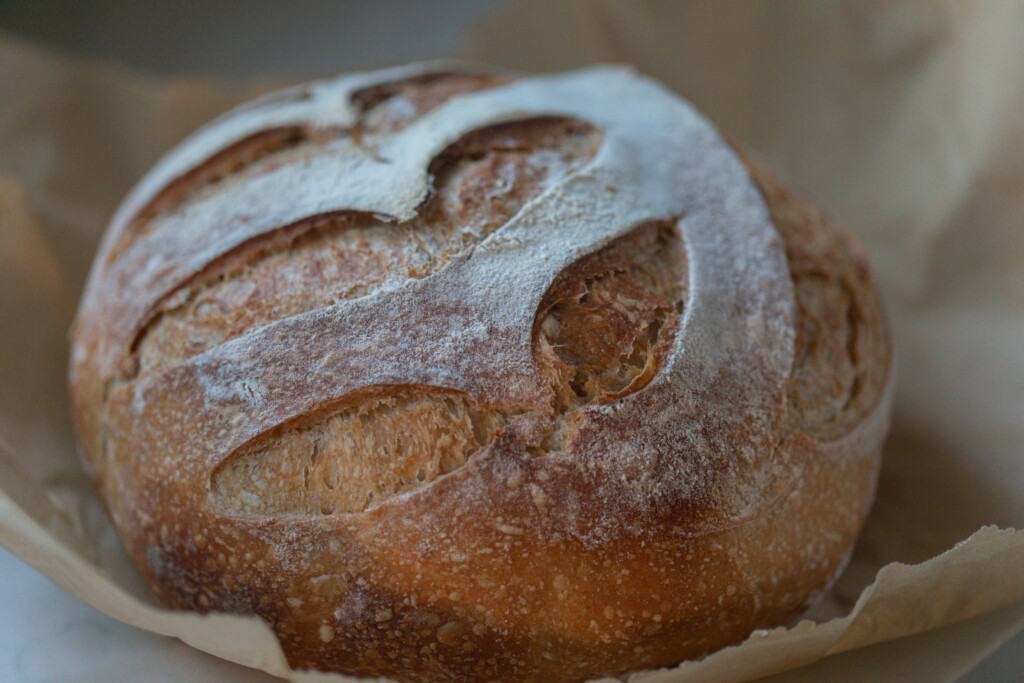
What is no knead sourdough bread?
This is a no knead recipe. Instead of kneading your bread, no knead bread involves what we call stretch and folds. The process of stretching your dough and folding it back in is how the gluten develops on these loaves.
To do a stretch and fold, simply grab the edge of the bread dough firmly and pull up, stretching it upwards. Then place the dough in your hands into the center. Turn the bowl about a quarter turn and do this stretch and fold again, and again one to two more times. This is considered one stretch and fold round.
This recipe requires 6 rounds of stretch and folds. Every recipe will vary!
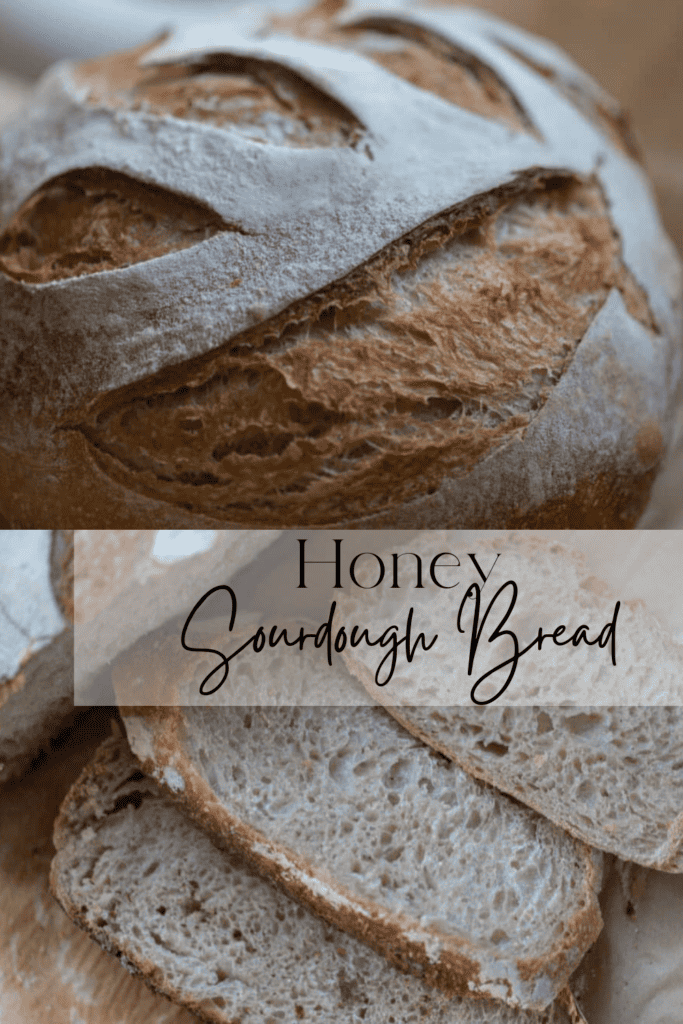
Why you’ll love this recipe
- Softer than a traditional loaf – Honey gives you a softer loaf, but still with that crusty exterior we all know and love.
- The health benefits of sourdough – Sourdough bread is a fermented bread that uses natural wild yeast to rise. Fermented grains tend to be more easily digested and provide beneficial bacteria for better gut health.
- Full of flavor – Tangy sourdough and the sweetness of honey will have your tastebuds singing.
Tips
- You will need an active starter to get the best results. Check out how to make a homemade sourdough starter here.
- To avoid a crust developing on your bread dough, be sure to cover it during the first rise with a damp towel, beeswax wrap, or plastic wrap.
- The rise time will vary depending on the temperature of your home, maturity of your starter and hydration status of the loaf.
- To get the perfect bread, I recommend using a kitchen scale to weigh your ingredients. If you do not have a kitchen scale, you can use my baking conversion chart here to convert your measurements into volume.
- New to sourdough? Check out my course Simple Sourdough to go from beginner to pro in no time.
This post contains affiliate links, which means I make a small commission at no extra cost to you. See my full disclosure here.
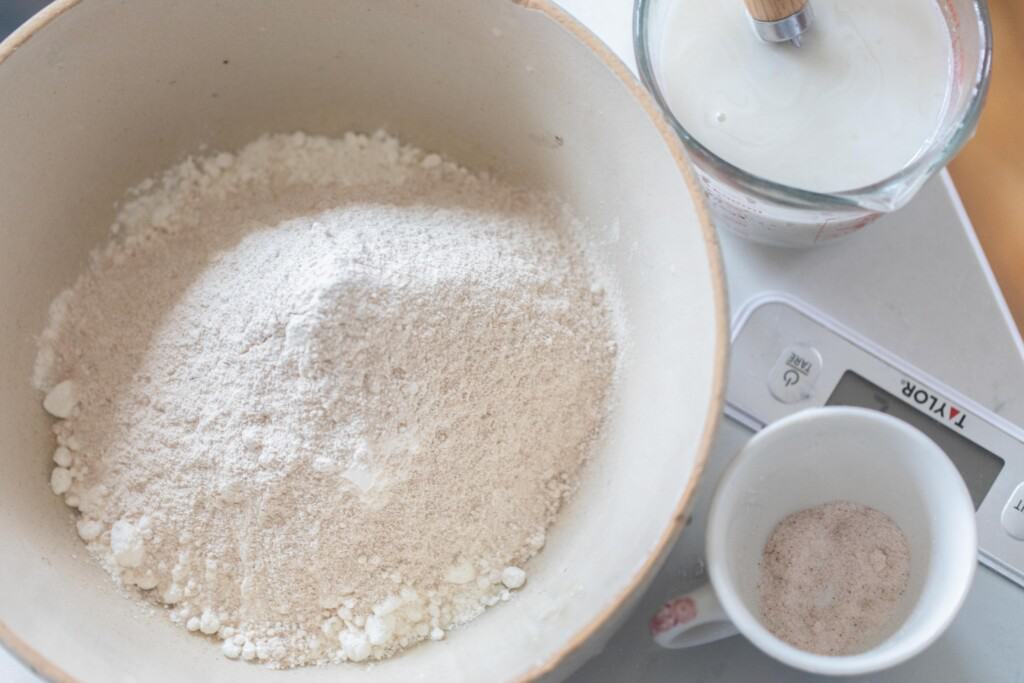
Ingredients
Sourdough starter, bubbly and active – Learn how to make your own sourdough starter here.
Water – For best results, use filtered water.
Honey – I prefer to use raw honey. Local honey is always best, too, if you can find it!
All purpose flour
Bread flour – If you do not have bread flour, you can replace it with more all purpose.
Whole wheat flour
Salt
Tools You May Need
Kitchen Scale
Scoring Lame or Razor Blade
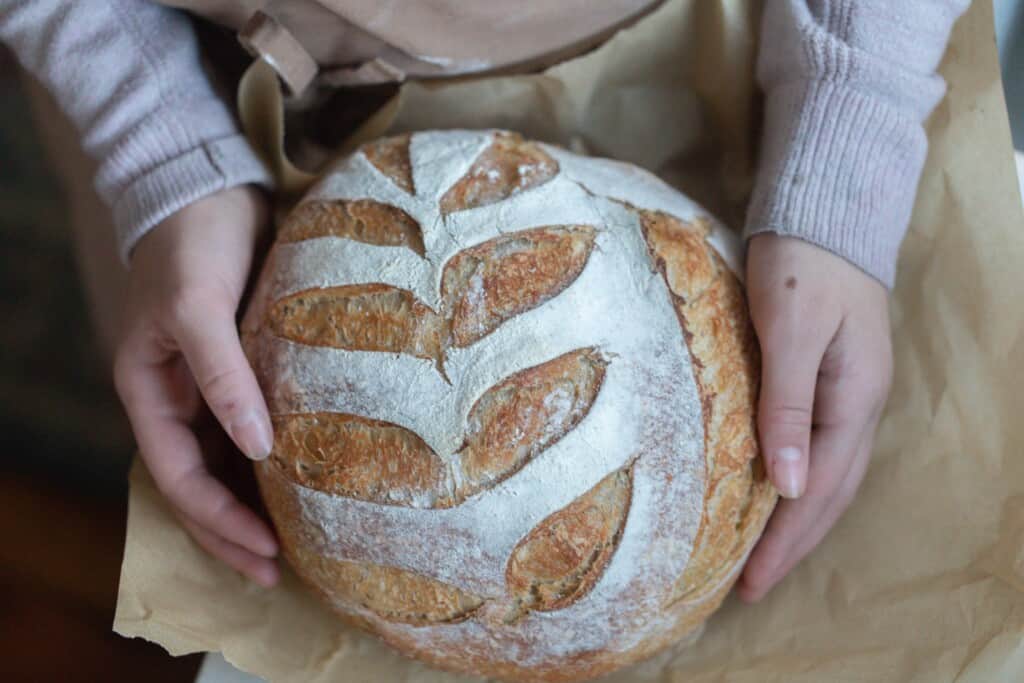
How to Make Honey Sourdough Bread
Feed a sourdough starter 4-12 hours before starting the bread, ensuring it is active and bubbly. The time it takes for your starter to become active depends on many factors, such as the temperature in your home, altitude, and maturity of your starter.
Mix Ingredients
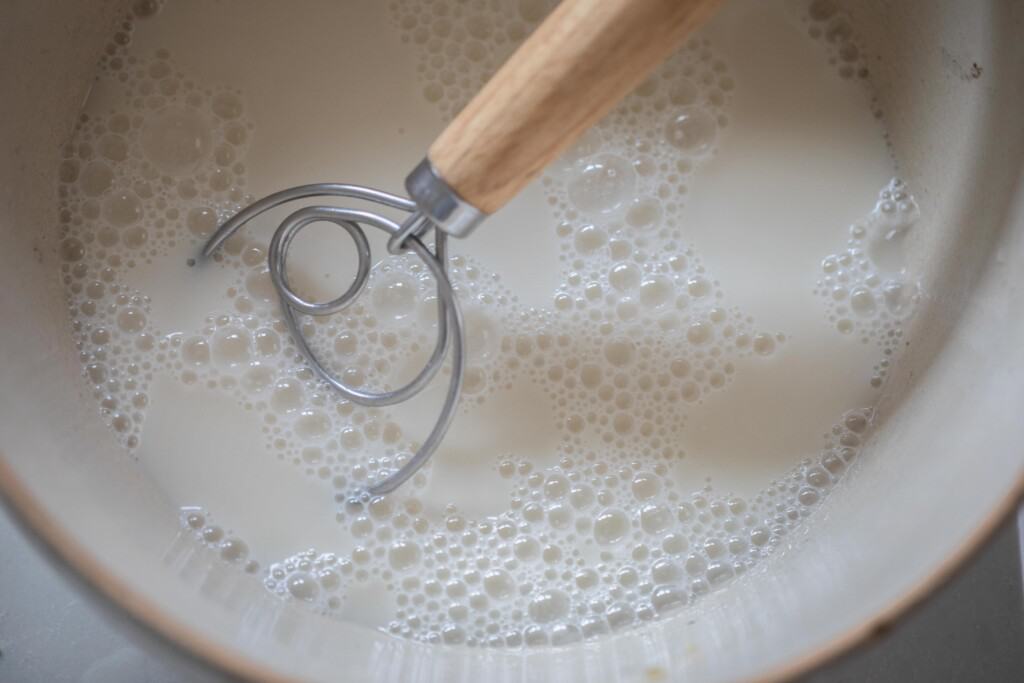
Mix your starter, water, and honey in a large bowl.
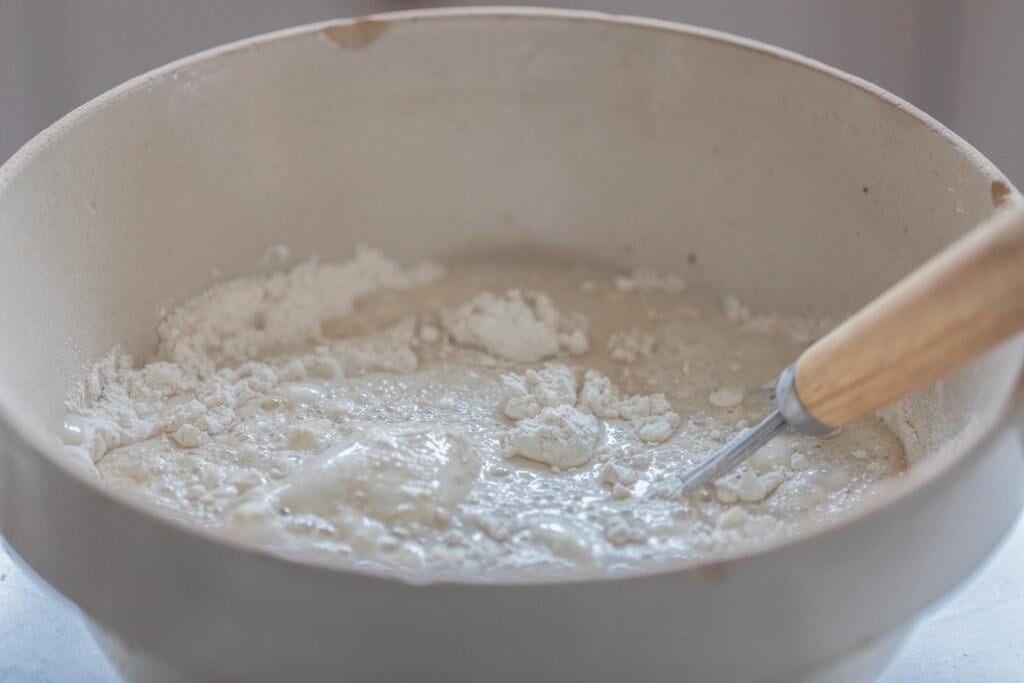
Add in flour and salt and mix with your hands to make a shaggy dough.
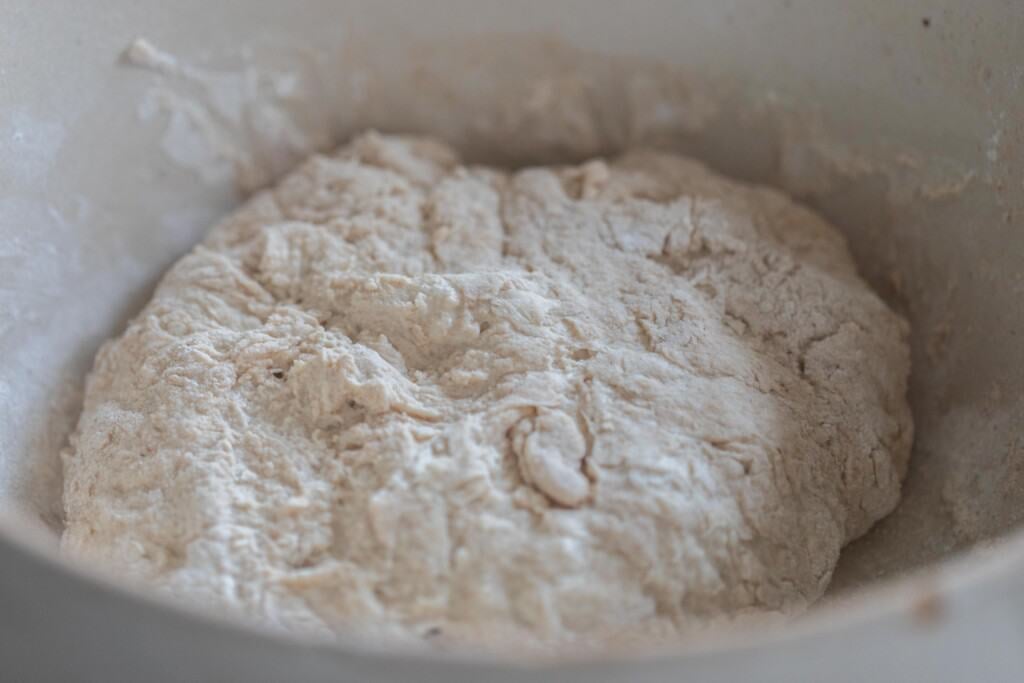
Cover the dough with a damp towel or beeswax wrap and allow to autolyse for 30 minutes. Autolyse is the process of hydrating the flour.
Stretch And Fold
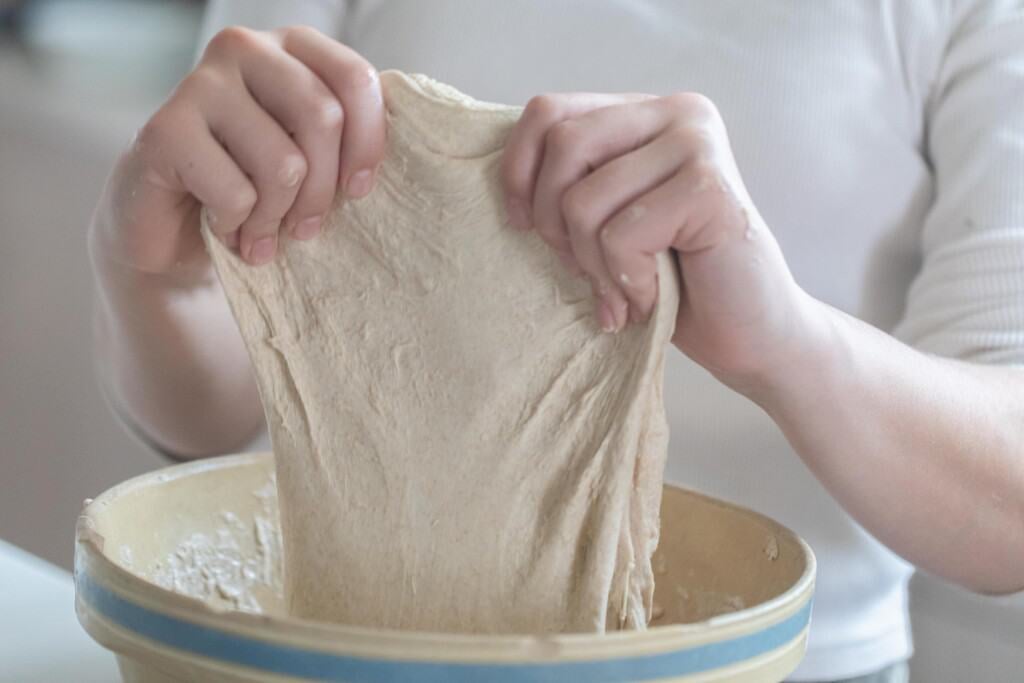
To develop the gluten and obtain a nice rise, you will want to do 6 rounds of stretching and folding.
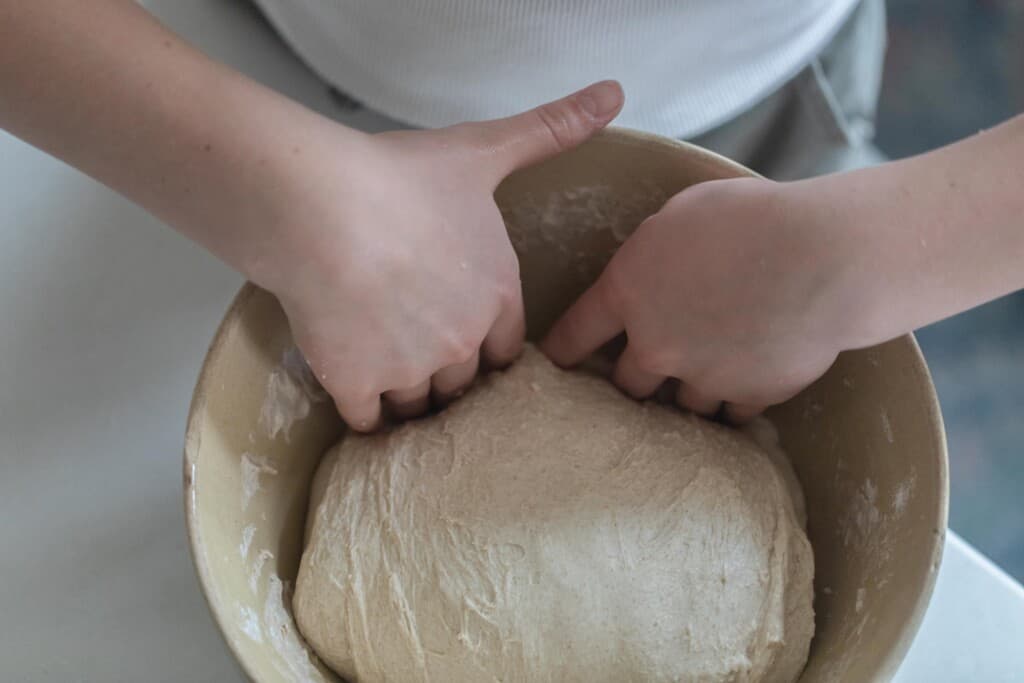
While the dough is in the bowl, grab the edge of the dough firmly and pull up, stretching it upwards. Then place the dough in your hands into the center. Turn the bowl about a quarter turn and do this stretch and fold again, and again one to two more times. This is considered one stretch and fold round. Repeat according to the directions below. Dip your hand in water if the dough is too sticky.
First 3 stretch and folds – every 15 minutes.
Last 3 stretch and folds – every 30 minutes.
Bulk Ferment
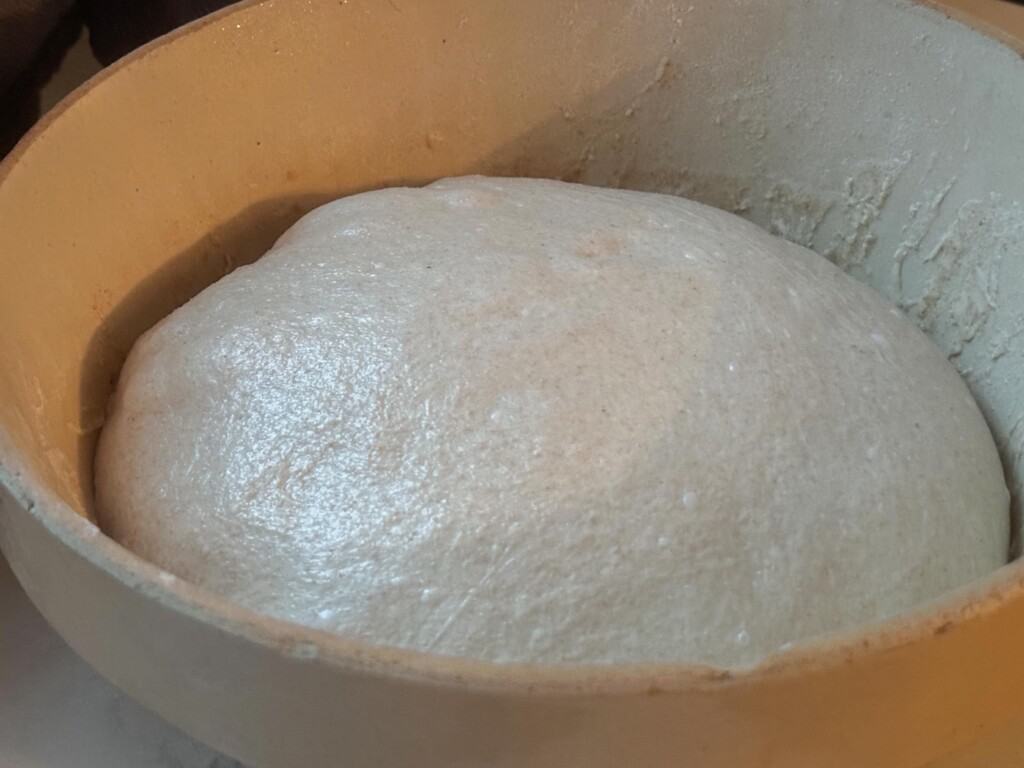
Cover with a wet towel or plastic wrap and allow the dough to bulk-ferment until doubled. The time this takes will vary for everyone and is dependent on many factors, including your environment and the maturity of your starter.
When it’s done, there should be bubbles all over the surface of your dough.
Shape
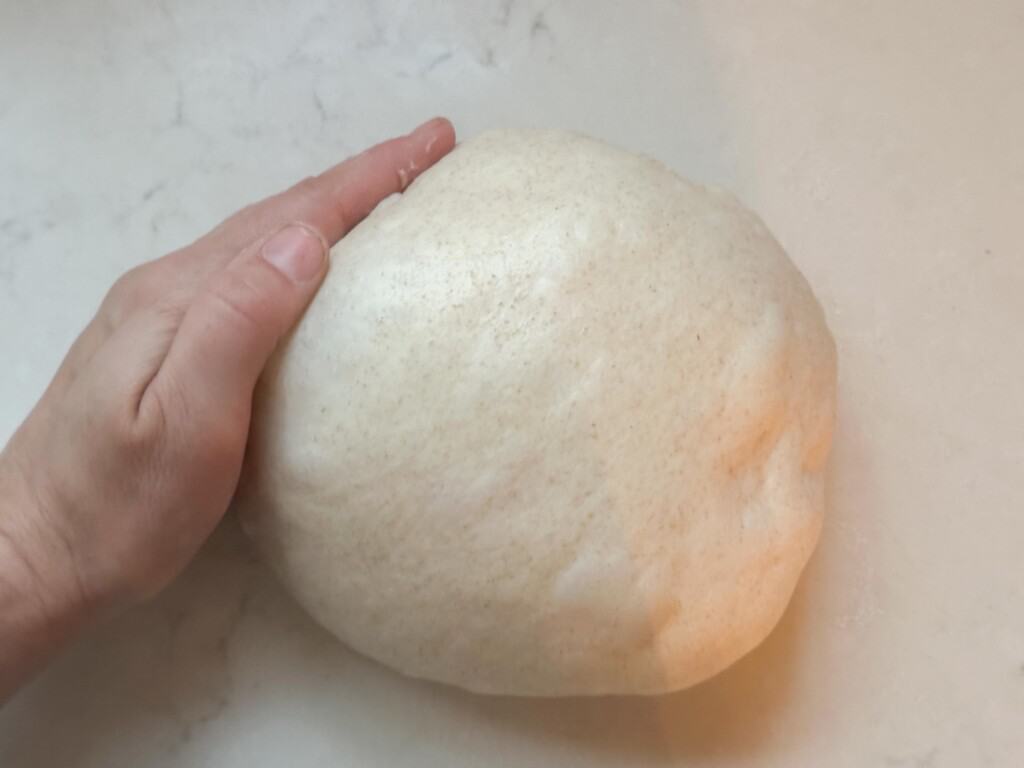
Shape into a ball by gently spinning it toward you.
Set out 15-20 minutes uncovered. This allows the surface to develop a skin, so that it doesn’t stick to the tea towel during the overnight rise.
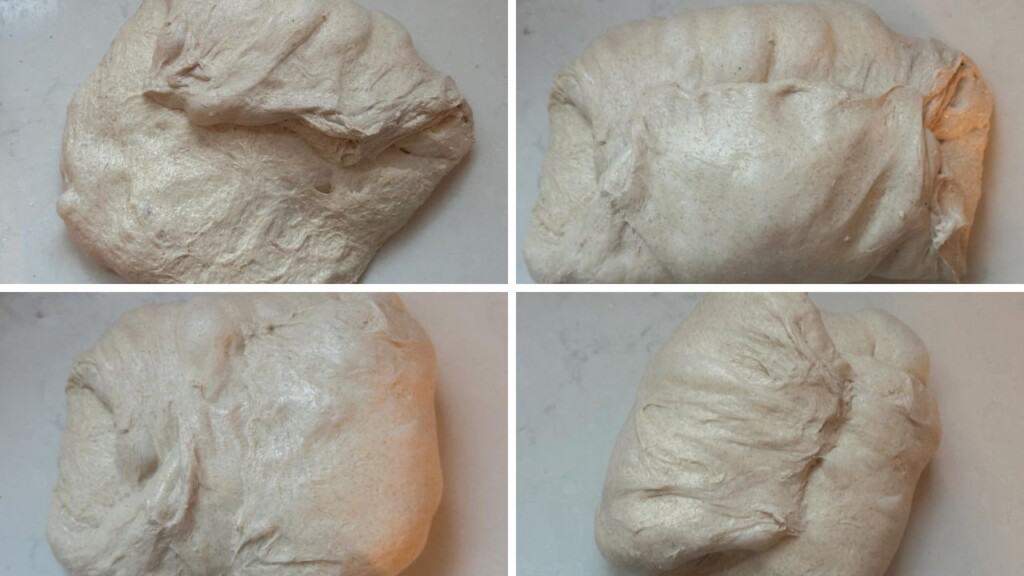
Turn over and shape. I do this by folding the two sides over to meet in the middle, and then the other two sides.
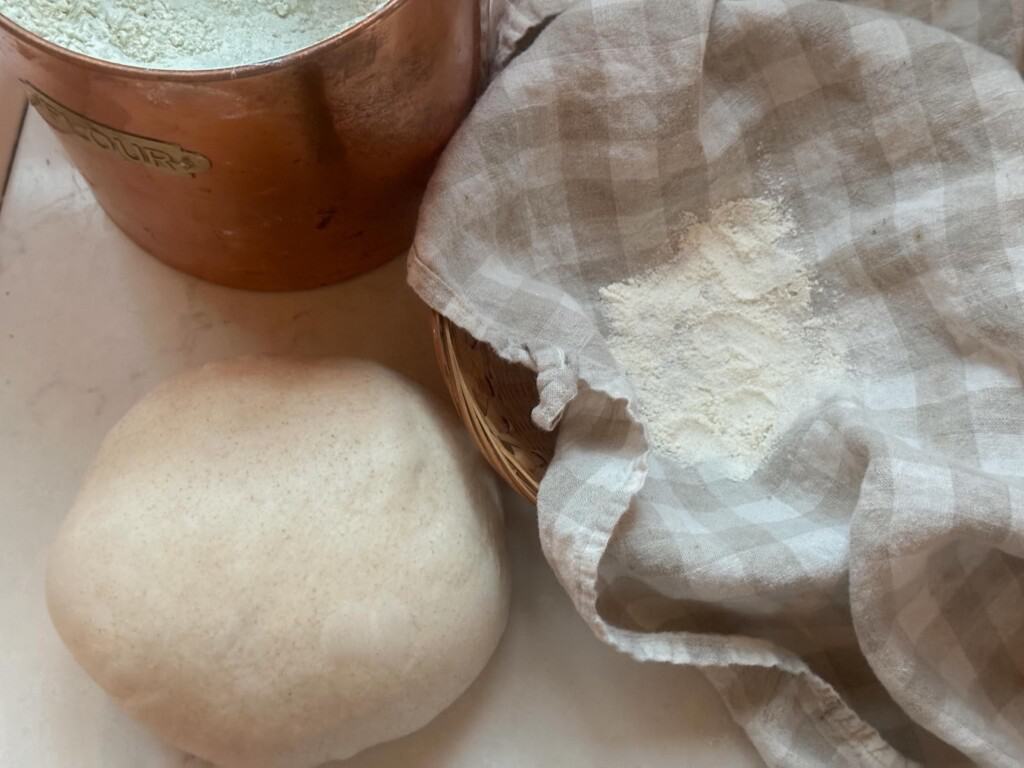
Transfer to a floured banneton basket. You can also use a bowl or basket with a floured tea towel instead. Place in your banneton or bowl seam side up. Cover with plastic and proof for 12-15 hours in the refrigerator.
Bake
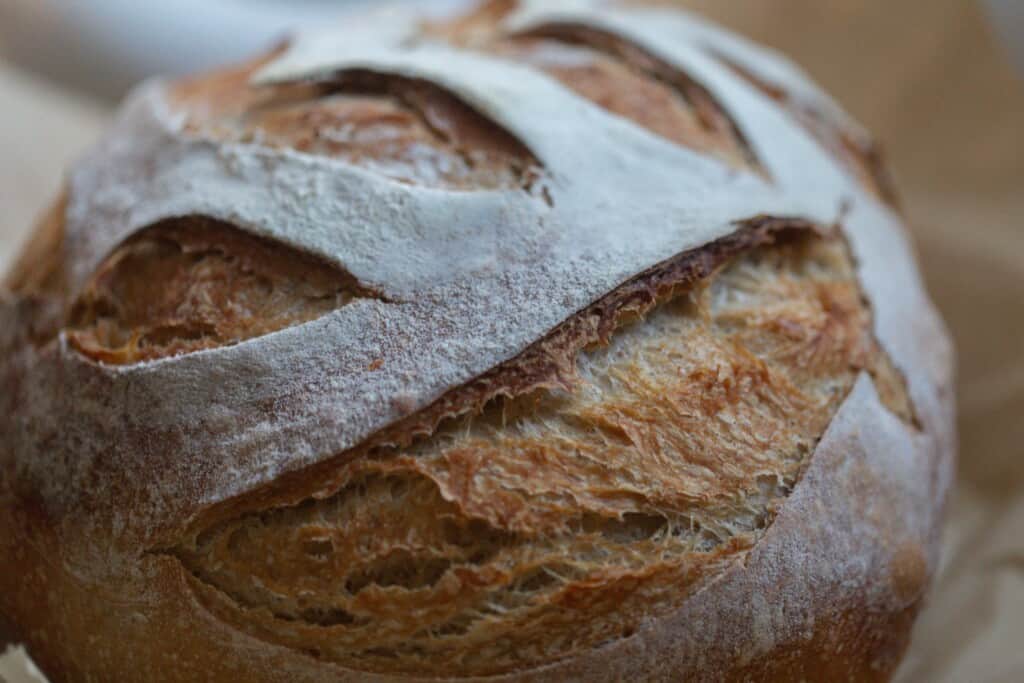
In a 500 degree oven, preheat your dutch oven for 1 hour.
Take the dough out of the fridge right before you are ready to bake.
Dust with flour on top to make the scoring pattern stand out more.
Score with a razor. Learn more about scoring patterns here.
Add a little flour to the bottom of the dutch oven (or parchment paper if using) and transfer dough to it.
Bake for 20 minutes at 500 with the lid on.
Turn the oven temperature down to 475 and remove the lid. Bake an additional 25 minutes or until your loaf is golden brown.
FAQ
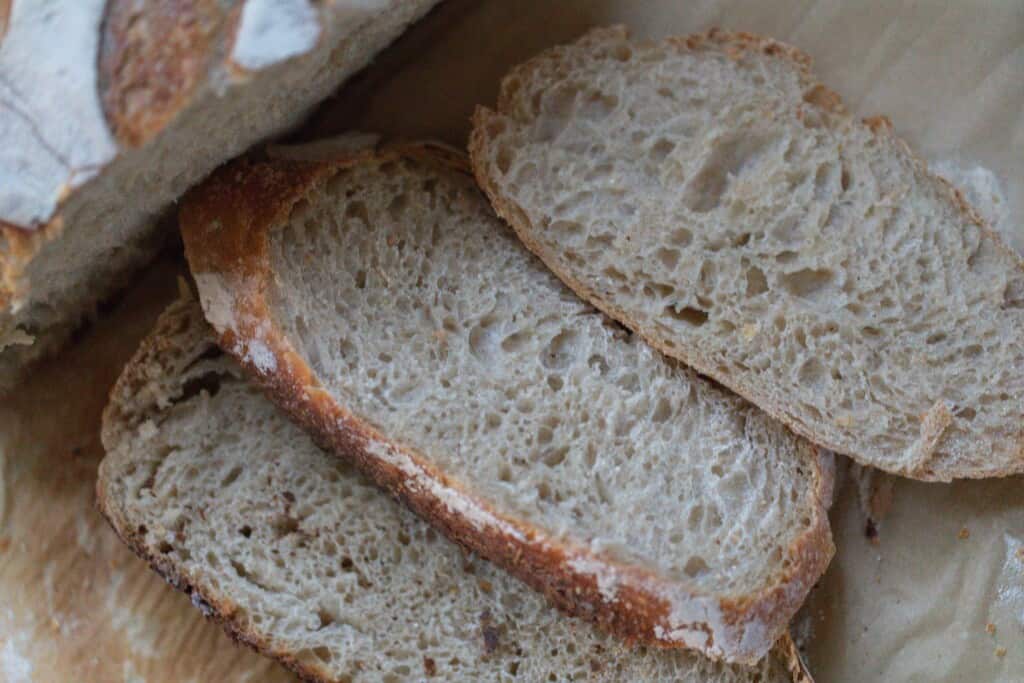
What does honey do to sourdough?
Honey will yield a softer loaf. Don’t worry, though, you’ll still get that crunchy exterior!
Is sourdough bread healthier than most bread?
Because you are working with fermented grains, sourdough tends to be easier to digest. It also contains beneficial bacteria for gut health.
What’s the best flour to use for sourdough bread?
I typically use unbleached all purpose, bread, and whole wheat flour. Some recipes will use just one type of flour and others are a combo. You can also use ancient grains, such as einkorn or spelt. Find my einkorn sourdough bread recipe here and my spelt loaf here.
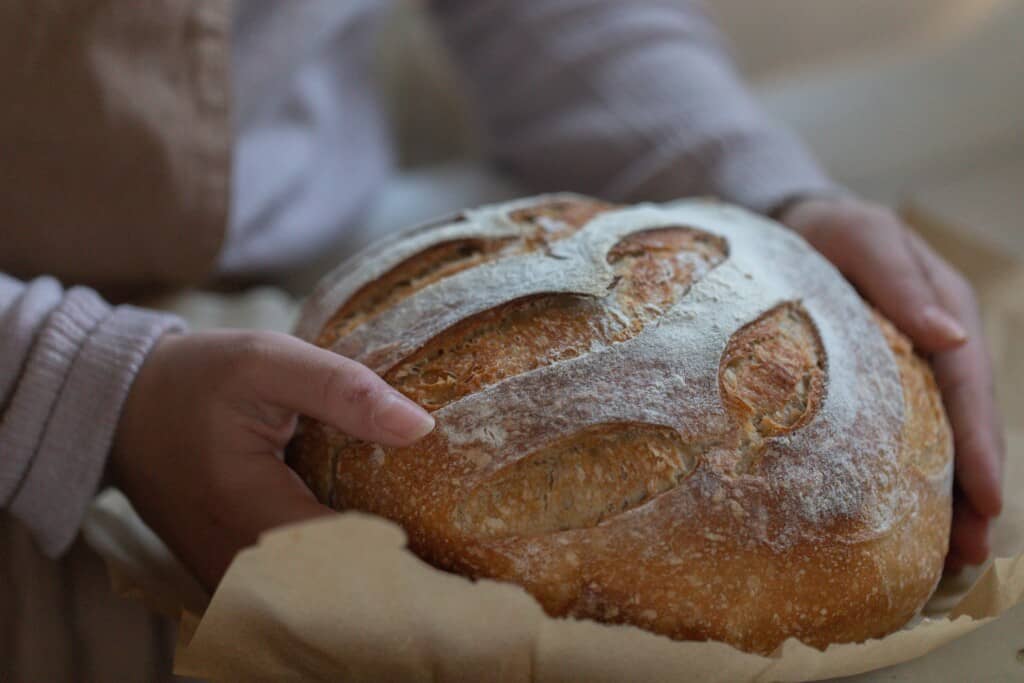
How to Enjoy Honey Sourdough Bread
This loaf is delicious all on its own. You can also add more flavor to that sourdough tang with a few toppings! Here are my favorites:
- Freshly whipped butter and strawberry jam
- Peanut butter and honey
- Sliced avocado – add a sunny side up egg on top for a delicious snack or breakfast!
You can also use this bread to make yummy grilled cheese or French Toast!
Storage
Learn more about how to store sourdough bread here. You can also freeze your loaf as a whole or even in slices.
Baker’s Timeline
8 am: Feed sourdough starter with flour and water.
12 pm: If sourdough starter is mature, then proceed to creating the dough.
Mix your starter, water, and honey in a large bowl. Add in flour and salt and mix with your hands to make a shaggy dough. Cover the dough with a damp towel or beeswax wrap and allow to autolyse for 30 minutes.
12:45ish pm: Stretch and fold.
First 3 stretch and folds – every 15 minutes
Last 3 stretch and folds – every 30 minutes
Cover with a wet towel or plastic wrap and allow the dough to bulk ferment until doubled.
8:00pm (may be much sooner): Shape dough.
Sit out 15-20 minutes, uncovered.
Turn over and shape.
8:30pm: Transfer to flour banneton or bowl with tea towel and cover with plastic. Place in the refrigerator for 12-15 hours.
The Next Day
9:00am: Preheat dutch oven on 500 degrees for 1 hour.
Take dough out of fridge, dust with flour, and score.
10:00am: Bake the sourdough bread and allow to cool.
More Sourdough Recipes from the Farmhouse
- Sourdough Brown Bread
- Mini Sourdough Loaves
- Sourdough Sandwich Bread
- 100% Whole Wheat Bread
- Seeded Sourdough Bread
If you try this recipe and love it, I would love if you gave it 5 stars! Also, tag me on Instagram @farmhouseonboone.
Honey Sourdough Bread
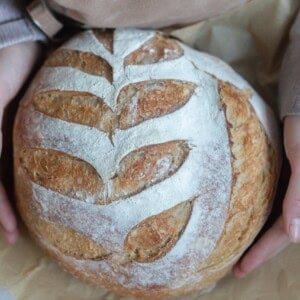
Ingredients
- 100 grams sourdough starter, bubbly and active
- 325 grams water
- 30 grams honey
- 250 grams all purpose flour
- 125 grams bread flour
- 100 grams whole wheat flour
- 10 grams salt
Instructions
- Feed a sourdough starter 4-12 hours before starting the bread, ensuring it is active and bubbly.
- Mix your starter, water, and honey in a large bowl.
- Add in flour and salt and mix with your hands to make a shaggy dough.
- Cover the dough with a damp towel or beeswax wrap and allow to autolyse for 30 minutes.
- To develop the gluten and obtain a nice rise, you will want to do 6 rounds of stretching and folding.
- While the dough is in the bowl, grab the edge and the dough firmly and pull up, stretching it upwards. Then place the dough in your hands into the center. Turn the bowl about a quarter turn and do this stretch and fold again, and again one to two more times. This is considered one stretch and fold round. Repeat according to the directions below. Dip your hand in water if the dough is too sticky.
- First 3 stretch and folds – every 15 minutes.
- Last 3 stretch and folds – every 30 minutes.
- Cover with a wet towel or plastic wrap and allow the dough to bulk-ferment until doubled. The time this takes will vary for everyone and is dependent on many factors, including your environment and the maturity of your starter.
- Shape into a ball by gently spinning it toward you.
- Set out 15-20 minutes uncovered. This allows the surface to develop a skin, so that it doesn’t stick to the tea towel during the overnight rise.
- Turn over and shape. I do this by folding the two sides over to meet in the middle, and then the other two sides.
- Transfer to a floured banneton basket. You can also use a bowl with a floured tea towel instead. Place in your banneton or bowl seam side up. Cover with plastic and proof for 12-15 hours in the refrigerator.
- In a 500 degree oven, preheat your dutch oven for 1 hour.
- Take the dough out of the fridge right before you are ready to bake.
- Dust with flour on top to make the scoring pattern stand out more.
- Score with a razor.
- Add a little flour to the bottom of the dutch oven (or parchment paper if using) and transfer dough to it.
- Bake for 20 minutes at 500 with the lid on.
- Turn the oven temperature down to 475 and remove the lid. Bake an additional 25 minutes or until your loaf is golden brown.
Notes
Nutrition
Nutrition information is automatically calculated, so should only be used as an approximation.

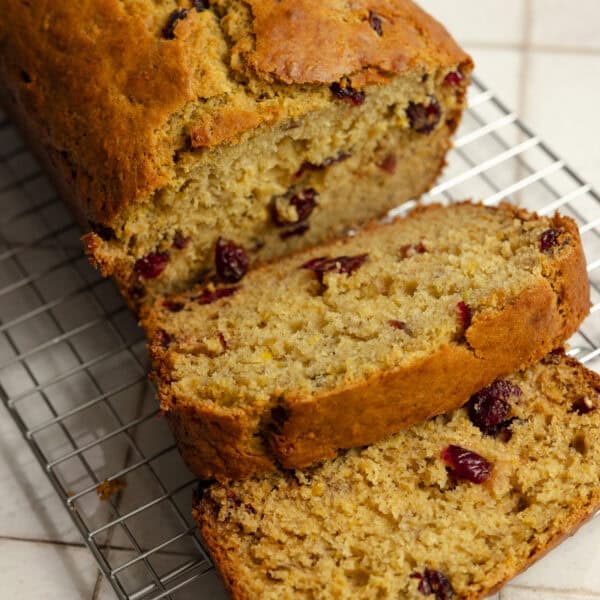

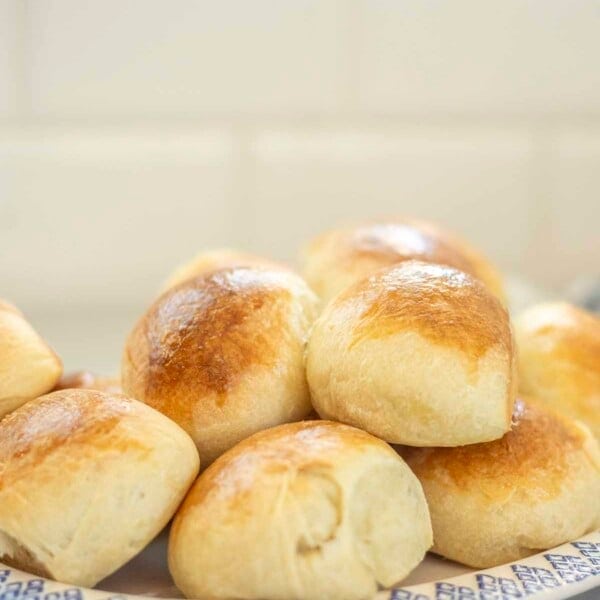






I did everything in the recipe, but after only 20 minutes with lid off at 475 it was burned. I’m hoping it’s still salvageable after cutting.
Hi! I was wondering if you could use bread pans instead of a Dutch oven.
The dutch oven really helps to create steam and producing a good loaf of bread!
This has become my all time favorite sourdough recipe. It’s simply wonderful
I don’t have any bread flour, is it worth trying without. Or is it important to use it?
You can use AP flour instead.
Thank you! I have really been enjoying the start of my sourdough journey and all your recipes have been my favorites! 🙏💜
Hi Lisa!
Can I sub rye flour for wheat flour? In any of your recipes for that matter?
If I have a recipe that specifically includes wheat flour, you should be able to sub rye in the recipe. I would not however sub all of the all purpose flour for rye flour in a recipe. Each type of flour needs a little different care and hydration amounts. Some of these recipes would not be suitable for an all rye dough without adjustments to the measurements of the ingredients.
My loaf was beautiful and proofed perfectly. Following the baking instructions, the oven was obviously (now, after the fact) way too hot – it burned the loaf. I am devastated. I will try again, but will decrease temperatures and duration.
Oh no! I hate to hear that. I would cutting off the burnt crust and using the rest for bread crumbs or croutons.
How much flour if I only use whole wheat flour?
I’m pretty new to sourdough and had tried 3 other recipes all of which were major failures. I was on the verge of giving up. Found this recipe the other day and decided to try it. It was my first successful loaf. Thank you lisa
What type of wheat berries do you use for this recipe?
Hard White Wheat
Thank you for the response! I just purchased a NutriMill and am trying to learn! This is my first experience with freshly ground flour. Do you use the hard white wheat for the AP, whole wheat and bread flour with varying levels of coarseness? Any recommended resources for learning more about using wheat berries? I have watched a few YouTube videos.
I’m looking forward to trying this recipe today. I found you on YouTube last summer. I started sourdough baking a year ago January 2023. I’ll never go back. ☺ From a fellow St. Louis-an.
Hope it turns out great!